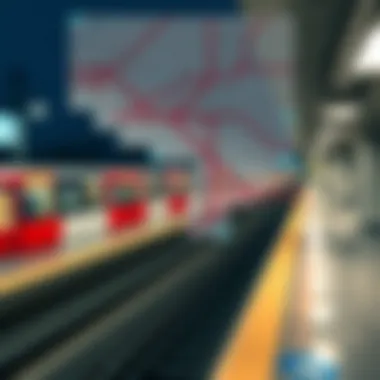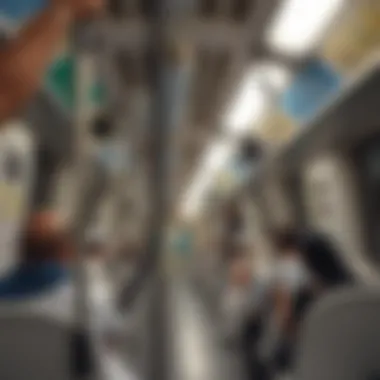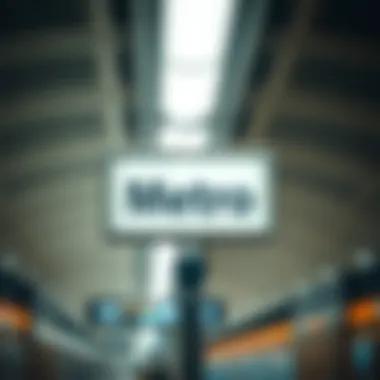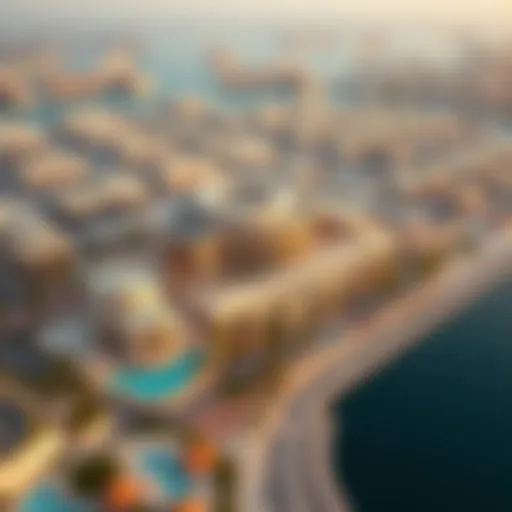Navigating Dubai Metro Maps: A Comprehensive Guide


Intro
Navigating the vast and bustling city of Dubai is no small feat, especially with its ever-expanding landscape. Yet, one of the most effective ways to traverse this urban marvel is through its efficient Metro system. Understanding the intricacies of the Dubai Metro maps is crucial for anyone looking to make informed decisions, whether for commuting or property investments.
The Dubai Metro, a marvel of modern engineering, connects key areas—from the glittering skyscrapers of Downtown to the tranquil beaches of Jumeirah. This guide will peel back the layers of the metro system, revealing how its routes and stations can significantly influence property values and investment potential.
The maps themselves are not merely tools for navigation; they encapsulate insights into accessibility and connectivity—both vital when considering real estate options. With this understanding, would-be investors, homeowners, and even seasoned agents can leverage the metro's design to make strategic decisions.
In esteeming the Dubai property market, knowledge of the transit network equates to power. Let’s dive deeper into the current market dynamics, forecasted trends, and essential investment guidance that will help navigate this exciting landscape.
Market Insights
Current Trends in Dubai Real Estate
Dubai's real estate market is a rollercoaster of activity. Recently, a surge in demand has got many industry experts buzzing about the future. Major developments and projects along the Metro lines are enticing buyers and investors alike.
Some noteworthy trends include:
- Increased property values: Areas closer to the Metro, like Dubai Marina and Burj Khalifa, have seen a steady rise in prices.
- Emerging neighborhoods: Locations like Jumeirah Village Circle (JVC) are gaining traction, largely due to their metro accessibility.
- Rental yields: Properties near the metro stations often command higher rents, making them attractive to landlords seeking good returns.
Analysis of Property Prices and Forecasts
The analysis of property prices in Dubai indicates a dynamic market influenced heavily by accessibility. As the Metro expands, the forecast suggests a continued upward trajectory in values for districts well-served by rail stations. According to recent data, property prices in these areas are expected to rise by 5%-10% annually, depending on the economic landscape and foreign investment inflow.
Investors should keep an eye on:
- New station openings: Each new station can shift market dynamics considerably.
- Infrastructure developments: Roads, schools, and hospitals near metro stations enhance attractiveness.
- Government policies: Regulations affecting foreigners can sway investment opportunities.
Understanding these trends and forecasts is paramount to making sound investment decisions.
Investment Guidance
Tips for First-Time Buyers in Dubai
For those looking to dip their toes into Dubai's real estate scene, here are some invaluable tips:
- Research the area: Investigate neighborhoods served by the Metro for potential growth.
- Visit the properties: Viewing sites near metro stations helps gauge the livability of an area.
- Check rental potential: Evaluate areas with high demand to ensure good ROI.
Key Factors to Consider for Property Investment
When considering a property investment, prioritize the following:
- Proximity to the Metro: Closer stations often equal higher property values and easier commuting.
- Development plans: Future projects around metro stations can drastically affect value.
- Market health: Keep updated with the local market trends and economic indicators.
Arming oneself with knowledge of the Dubai Metro and its connection to real estate is not just wise; it is essential in today’s fast-paced investment world. The Dubai property landscape, shaped by metro access, offers untold possibilities for those ready to explore its depths.
Prologue to Dubai Metro
Navigating one of the fastest-growing cities in the world, the Dubai Metro serves as a cornerstone of urban mobility in the United Arab Emirates. Understanding its significance offers an insight into the cultural and economic fabric of this bustling metropolis.
Overview of the Metro System
Dubbed as the lifeblood of public transportation in Dubai, the Metro system is not just a means to commute; it’s a sophisticated network designed with both functionality and efficiency in mind. Opened in 2009, the Dubai Metro operates across two main lines: the Red Line and the Green Line, which together span over 75 kilometers.
The trains are automatic, offering commuters a seamless experience without a single conductor. Each station, designed with a modern aesthetic, is equipped with high-tech amenities like electronic displays and accessibility options. This reflects Dubai’s commitment to technological advancement and user-centric design.
Moreover, with numerous stations that connect key locations including the Dubai Mall, Dubai Marina, and the airport, there is ample convenience for those looking to navigate the city's playground. Knowing the Metro layout can save both time and money, making it a prime focus for anyone considering property investments or regular commuting in Dubai.
Importance of Public Transportation in Dubai


In a city where luxury cars line the streets, one might ponder the need for a comprehensive public transport system. However, public transportation in Dubai is essential for several reasons. Firstly, it addresses traffic congestion, a common woe in urban landscapes. With a growing population exceeding 3 million, efficient transit infrastructure is crucial to keep the city moving.
Secondly, the Metro enhances accessibility for various demographics, including expats and low-income workers who may not own personal vehicles. Public transportation underscores inclusivity, connecting various communities throughout the city.
Lastly, the existence of a robust public transport system, such as the Metro, often results in elevated property values. Investors and homeowners should be keenly aware of how accessibility impacts real estate decisions.
In summary, the Dubai Metro is not merely about getting from point A to B; it represents a broader vision of a connected future for real estate, urban life, and the city’s culture.
Key Features of the Dubai Metro
The Dubai Metro is not just a means of transportation; it stands as a testament to modern engineering and urban planning. Understanding its key features is crucial, especially for those considering how this system intertwines with the city's growth and real estate dynamics. The benefits of a well-connected metro system stretch far and wide. Key features include:
- Automation: The fully automated train operation ensures efficiency and safety.
- Architectural Design: The aesthetics of the stations play an integral role in Dubai's skyline.
- Accessibility: Universal design principles make the metro user-friendly for everyone.
In the following sections, each of these specifics will be examined in detail, highlighting how they weave into the broader fabric of the city's transportation network.
Automated Train Operations
One of the most striking features of the Dubai Metro is its automated train operations. This system runs without a human driver, utilizing advanced technology that guarantees a safe and punctual travel experience. Passengers benefit greatly from the train's frequency, with intervals often less than five minutes during peak hours. This level of efficiency significantly reduces wait times, making commuting less of a hassle.
Moreover, automation enhances safety. With an extensive network of sensors and monitoring systems, the risk of human error is diminished, thereby creating a smooth journey for all riders. Each train is monitored from a central control room, ensuring it operates efficiently and adjusts to any real-time challenges such as track conditions or passenger loads.
Stations and Architecture
When it comes to the stations, they are undeniably a visual highlight. Each station along the Dubai Metro is a marvel of modern architecture, designed not only for functionality but also for aesthetic appeal. From the sleek lines of the exterior to the carefully curated interiors, these stations echo Dubai's spirit of innovation.
Major stations, such as Union and Burjuman, are often adorned with art installations and retail outlets, providing a vibrant atmosphere that attracts both commuters and tourists alike. The designs reflect local culture while embracing futuristic concepts, creating a striking contrast against the backdrop of traditional Dubai.
The strategic placement of these stations caters to key urban sectors, further enhancing accessibility throughout the city. For instance, many are located in proximity to shopping malls, cultural landmarks, and business districts, making them indispensable to daily commuting.
Accessibility and User Experience
Accessibility is a cornerstone of the Dubai Metro system. Special considerations have been made to include facilities for those with reduced mobility, ensuring that trolleys, ramps, and designated seating are available throughout the stations and trains. This commitment to inclusivity means that residents and visitors alike can navigate the city with ease.
Furthermore, user experience extends beyond just physical accessibility. The metro system incorporates user-friendly navigation features such as clear signage in multiple languages, touchscreen information kiosks, and a reliable online mobile app that provides live updates on train schedules. This encourages even the most hesitant first-time travelers to hop on board.
In summary, understanding the key features of the Dubai Metro underscores its role not only as a transportation backbone for the city but as a significant asset in real estate investments and urban development. Investors and residents alike can benefit from knowing how the metro system aligns with Dubai’s ambitious growth plans.
"In a city defined by its rapid transformation, the metro system is not just about getting from Point A to Point B; it's about connecting communities and enriching lives."
For additional insights, you may explore the following resources:
Understanding these features can significantly influence real estate decisions, as proximity to a metro station often correlates with market value and desirability.
Exploring the Dubai Metro Map
Understanding the Dubai Metro map is crucial for anyone looking to navigate this bustling city efficiently. Both residents and visitors can significantly benefit from familiarizing themselves with its layout and the opportunities it presents. The map is more than just a guide to the tracks; it represents the arteries of urban life in Dubai, connecting diverse neighborhoods, commercial hotspots, and cultural landmarks.
Lines and Routes Overview
The Dubai Metro consists of two primary lines: the Red Line and the Green Line. Each line has distinct features, catering to various commuting needs. The Red Line runs along Sheikh Zayed Road, connecting areas from Rashidiya to the UAE Exchange, while the Green Line traverses the older parts of the city, extending from Etisalat to Dubai Marina.
The trains are frequent, typically running every few minutes, which means that waiting time is minimal. Using the metro not only saves time during peak hours but also offers a hassle-free traveling experience compared to navigating the crowded streets of the city.
- Red Line Highlights:
- Green Line Highlights:
- Attracts a mix of tourists and daily commuters.
- Key stops include the Burj Khalifa, Dubai Mall, and the Mall of the Emirates.
- Serves more local neighborhoods and cultural sites.
- Important stations include Al Fahidi, known for its heritage sites, and the Dubai Historical District.


Familiarizing oneself with these lines lays a solid groundwork for efficient travel, hence, it’s wise to study this important resource even before setting foot in the metro.
Major Stations and Transfers
When you look at a metro map, it’s impossible to ignore the pivotal stations that serve as transfer points. These hubs not only allow for easy switches between lines but often host various amenities that can enhance your journey. Key transfer stations like Union and Burjuman are vital cogs in the transit wheel of Dubai.
- Union Station:
- Burjuman Station:
- Connects both the Red and Green Lines.
- Close to Deira, a vibrant area for shopping and dining.
- Another critical hub for interchange.
- Convenient access to the Burjuman Shopping Centre, which serves as a commercial attraction.
Navigating between lines can sometimes be intimidating, especially during busy hours. Understanding these stations can save valuable time and prevent confusion. If you’re in a hurry, prioritizing travel along these routes can ensure you reach your destination swiftly.
"A good map isn’t just a guide; it’s a key to unlocking the full experience of a city."
In summation, taking the time to explore and understand the Dubai Metro map is integral to navigating the city. The lines, routes, and major stations are not just about transportation; they're about connecting the dots of daily life in this thriving metropolis. Whether you're an investor, a homeowner, or simply exploring the city, being savvy about the metro can lead to better decisions and richer experiences.
Understanding Station Locations
Understanding the location of Metro stations is pivotal for anyone looking to live, work, or invest in Dubai. The positioning of these stations directly influences accessibility to key amenities, commercial centers, and residential areas. For residents, proximity to a station can mean quicker commutes and an enhanced quality of life. Additionally, for investors and potential homeowners, discerning where the stations lie can provide insights into future property values and desirability.
Residential Areas and Proximity to Stations
Proximity to Metro stations is not just a convenience; it can significantly shape lifestyle options for residents. Living near a Metro station often means less reliance on personal vehicles, lowering commuting costs and providing easier access to key districts.
- Convenience of Access: Residents living within walking distance of a station enjoy hassle-free transport. This means less time stuck in traffic, particularly during peak hours. In a bustling city like Dubai, where road congestion can be a daily battle, this advantage cannot be overstated.
- Neighborhood Appeal: Many residential developments are consciously designed around Metro convenience. Areas like Dubai Marina and Jumeirah Lake Towers have seen an uptick in desirability, largely due to their close proximity to Metro stations. These neighborhoods facilitate a lifestyle where residents can easily access shopping, dining, and leisure activities.
- Potential for Higher Property Values: Properties near Metro stations often fetch a higher price in the market. This is not merely a trend; it is a manifestation of the link between public transport access and real estate value. As demand for ease and accessibility grows, homes situated near transit lines can attract both renters and buyers eager for a prime spot.
Commercial Hubs Connected by Metro
The Dubai Metro is not just a lifeline for residents; it connects a multitude of commercial hubs, which significantly contributes to economic activity in the city. Major business districts are strategically linked through the Metro, enabling seamless transitions for employees and clients alike.
- Key Areas of Activity: Prominent commercial centers like Dubai World Trade Centre, Business Bay, and Deira are all within reach of Metro stations. This connectivity ensures businesses thrive as employees enjoy shorter, more predictable commutes.
- Networking and Business Opportunities: For people in the business world, having easy access via Metro can translate to enhanced networking opportunities. Professionals can attend meetings or events across the city without the stress of car travel. The interlinked design of the Metro allows for more time spent on what matters — building business relationships.
- Growth in Commercial Real Estate: Investors should also note that commercial properties near Metro connections tend to retain robust demand. As companies opt for locations that allow for flexible commutes, properties in these areas become more attractive investments.
Impact on Real Estate Market
The essence of any urban setting is often tied to its transportation infrastructure, and Dubai is no exception. With the Dubai Metro serving as a critical artery of the city, its impact on the real estate market cannot be overstated. This section explores how the metro system affects property values and informs development trends. For investors, homeowners, and developers, understanding these dynamics can be crucial in making informed decisions in a fast-paced market.
Property Values Near Metro Stations
One of the most pronounced effects of the Dubai Metro is its influence on property values within proximity to its stations. Generally speaking, properties that are closer to metro stations command higher prices. This trend can be attributed to increased accessibility and convenience provided to residents. People typically have a strong preference for living near public transport due to the ease of commuting, which can lead to a stable demand for housing in these areas.
Consider areas like Dubai Marina and Jumeirah Lakes Towers, where proximity to metro stations has significantly enhanced the allure of real estate investments. Properties here are often marketed with the added benefit of quick access to the metro, making them more attractive to potential buyers and renters alike.
- Increased accessibility: Being near a metro station means that residents can commmute easily to work, shopping centers, and entertainment hubs.
- Rental prices surge: For landlords, investing in real estate close to metro stations often yields higher rental returns, as tenants seek convenience in their daily lives.
- Higher demand: Demand for properties near metro stations remains strong, even during economic downturns, due to the appeal of convenient transportation.
"Living close to the metro is an aspirational choice for residents; it's more than just a convenient commute. It’s a quality of life enhancement.”
Development Trends Linked to Metro Expansion
As Dubai continues to grow and the metro system expands, various development trends are emerging that correlate with this infrastructure investment. Real estate developers are increasingly looking towards areas slated for new metro stations, as these sites offer immense potential for growth. Here are some noteworthy points regarding these trends:
- Emerging neighborhoods: Previously overlooked areas suddenly gain spotlight as new metro lines are planned, providing a unique opportunity for early investors.
- Commercial developments: With the rise in residential properties near metro stations, there’s also a corresponding increase in commercial developments, geared to serve the local population.
- Government initiatives: The Dubai government has laid out extensive plans for metro expansion, which signals to developers that investing in these areas is a prudent long-term strategy.
Navigating Dubai with Metro Maps
Navigating the vibrant city of Dubai can be a puzzle for many, especially for newcomers or those not familiar with the public transit system. The Dubai Metro not only serves as a lifeline for the bustling city but also represents an efficient and cost-effective method of traversing through various neighborhoods and attractions. Understanding how to read and utilize metro maps is crucial for anyone looking to make the most out of their travel experience in Dubai.
Tips for First-Time Users
For those who are boarding the Dubai Metro for the first time, a few tips can make the journey seamless and enjoyable:


- Familiarize Yourself with the Map: Before stepping onto the platform, take a moment to glance over the metro map. The lines are color-coded, making it easier to identify which route to take. Each station is also marked clearly, so identifying your starting point and the final destination becomes a straightforward task.
- Purchase a Nol Card: To ride the metro, you’ll need a Nol Card, which acts like a prepaid travel card. You can buy one at the station, and it’s usable on buses and water taxis too. Remember to reload it if you plan to travel extensively!
- Learn the Peak Hours: Dubai Metro can get packed during peak hours, usually from 7 to 9 AM and 5 to 8 PM. If you fancy a little more elbow room, consider planing your rides outside these times when the metro is relatively empty.
"With a bit of preparation, navigating the Dubai Metro can transform from a daunting task into an effortless journey through the city."
- Seek Assistance When Needed: If you find yourself getting lost or confused, don't hesitate to approach station staff. They are friendly and can assist with directions or any questions.
- Know Your Stops: If your destination involves multiple changes, take note of the major stations where you will transfer lines. This knowledge will save time and keep your travel flow steady.
Mobile Applications and Resources
In today’s digital age, various mobile applications are available that can elevate your Dubai Metro experience. Here are a few valuable resources:
- Dubai Metro Official App: This app provides real-time updates on metro timings, a digital map, and alerts on any service disruptions. It’s a handy companion for any traveler.
- Google Maps: Besides providing directions for walking and driving, Google Maps is efficient for public transport routes. You'll find multiple transit options that can guide you on the quickest ways to your desired locations.
- RTA Dubai App: The Roads and Transport Authority (RTA) app not only allows users to plan routes but also facilitates Nol card management and payment processes for various transport services.
- Community Resources: Websites and forums like Reddit can serve as additional platforms to gather tips and experiences from expats and travelers who have navigated the city’s metro.
By utilizing these maps and resources, you can significantly enhance your ability to move around the city efficiently.
As public transportation in Dubai continues to improve, keeping pace with these developments ensures that everyone, whether a long-term resident or a visitor, can enjoy the best that the city has to offer.
Future of Dubai Metro System
The future of the Dubai Metro system holds a pivotal role in enhancing public transportation efficiency and reshaping urban landscapes. As one of the cornerstones of Dubai's infrastructure, the metro's evolution is driven by the growing demands of a bustling metropolis, making it a critical subject for investors, homeowners, agents, developers, and expatriates alike. Understanding its upcoming developments and its role in sustainable urban planning can offer insights into the city’s ambition to remain a global hub for tourism and commerce.
Upcoming Extensions and Developments
The Dubai Metro system is not resting on its laurels; instead, it is gearing up for a series of extensions that promise to enhance connectivity across the emirates. These expansions are not just about laying down additional tracks; they're about creating a seamless travel experience that embodies convenience and accessibility.
- Route 2020: This expansion connects the existing Red Line to the new Universal Expo 2020 site. Spanning a distance of approximately 15 kilometers, it includes seven new stations, allowing both residents and visitors easy access to major attractions.
- Green Line Extensions: Plans are underway to extend the Green Line towards Dubai's southern fringes, including areas like Dubai Silicon Oasis and Academic City. This move aims to cater to the increasing population in these developing neighborhoods.
- Potential Future Lines: Rumors suggest the introduction of additional color-coded lines that will link to other emirates, reducing dependency on personal vehicles and enhancing cross-emirate travel.
These extensions bring about significant economic implications. Property values near the new stations are expected to climb, making investments in the regions surrounding stations a savvy move for those looking to capitalize on real estate trends. Furthermore, updated metro maps will illustrate these new routes, assisting commuters in navigating the expanding system effectively.
"The expansion of public transit systems often heralds increased property values and economic development in their vicinities."
Role in Sustainable Urban Planning
Sustainable urban planning hinges upon effective public transportation systems that minimize urban sprawl and dependency on cars. The Dubai Metro is a shining example of how smart investment in transit can contribute to a more sustainable urban environment.
- Reduction in Carbon Footprint: By promoting public transport over personal vehicles, the metro significantly lowers greenhouse gas emissions, supporting Dubai’s ambitious goals for sustainability.
- Encouraging Compact Development: The metro encourages high-density, mixed-use developments around stations. This not only leads to more vibrant communities but also reduces the need for expansive road networks.
- Integration with Other Transport Modes: Future plans include seamless integration with bus services, trams, and potentially rideshare options, making it easier for commuters to shift from one mode of transport to another without a hitch.
Investors should take note: areas around metro stations that are designed with sustainability in mind are likely to yield higher returns, as they attract residents who prioritize eco-friendly living environments. Moreover, understanding the relationship between urban transit and real estate development can profoundly inform investment decisions, leading to more thoughtful and strategic property purchases.
For further insights into the role of urban transit in sustainable city planning, consider exploring resources from UN-Habitat or Transport for the Future.
In culmination, as the Dubai Metro continues its growth and integration within the urban fabric of the city, it presents vast opportunities and considerations for various stakeholders. By keeping an eye on upcoming developments and understanding their environmental implications, investors and residents can harness the full potential of the Dubai Metro system.
Closure
The end of this comprehensive guide is not just a conclusion, but a springboard into the diverse layers of the Dubai Metro system. The content we've explored emphasizes the profound impact that understanding metro maps has on both residents and investors in Dubai. Knowing what the metro has to offer isn’t just about simple navigation; it’s about grasping how this infrastructure braids into the very fabric of Dubai’s urban living and real estate market.
Revisiting the Importance of Metro Maps
Metro maps are more than colored lines and station names on a piece of paper. They symbolize connectivity and accessibility throughout Dubai’s vast cityscape. When individuals familiarize themselves with the metro maps, they unlock a practical tool that can change the quality of their daily life.
For instance, knowing the proximity of major stations to residential areas can help families choose a home that minimizes commuting time. As the metro has steadily evolved, so too has the complexity of its maps, reflecting new lines and expanded routes. Investors can read the tea leaves here; a station’s expansion can herald a surge in nearby property values.
The importance of these maps also extends to tourists and newcomers. Having a grasp of the metro layout can mean the difference between feeling lost in a sprawling city and confidently navigating from one attraction to another. More than a transit guide, metro maps are a testament to the growth and dynamism of Dubai itself.
Encouragement for Informed Property Decisions
In a market as vigorous as Dubai’s, property decisions shouldn't be made lightly. The intricate dance of factors influencing property values can often seem daunting. However, understanding the Dubai Metro system can arm investors and homeowners with critical tools.
Property analysts frequently look at the distance from metro stations when evaluating a property's potential. If a home is within walking distance from a bustling station, it stands a good chance of retaining or appreciating in value as urban development flourishes around transportation hubs. This is especially true in areas poised for upcoming metro expansions, where investors can often find hidden gems.
Moreover, being informed about how transit access affects local amenities can assist buyers in making more strategic decisions. For example, homes near the Dubai Mall or the World Trade Center station not only provide excellent transportation options but also proximity to shopping and entertainment, increasingly appealing traits for potential buyers.
In summary, the knowledge of metro maps isn't just about knowing when the next train arrives; it’s about understanding how and where to plant roots in Dubai's thriving real estate landscape. Having this knowledge is invaluable – for residents seeking convenience and investors looking for profitable opportunities.
"Invest in knowledge, as it pays the best interest." - Benjamin Franklin
To delve deeper, consider checking resources like Wikipedia or Britannica for additional insights into Dubai’s transportation system. Additionally, discussions on Reddit can provide on-the-ground perspectives and personal experiences from those living and working in the city.







